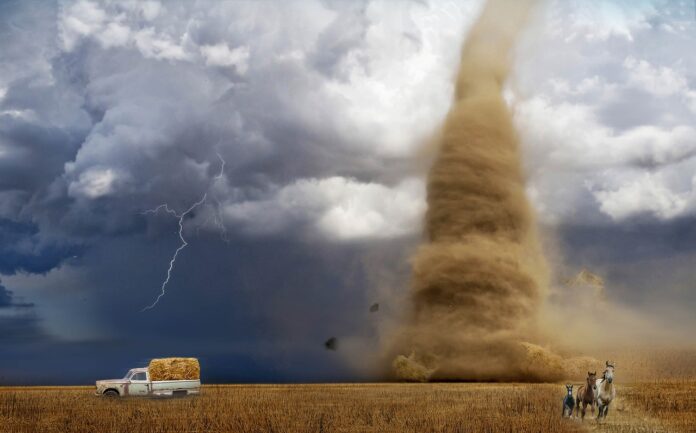A tornado is a powerful, spinning column of air that stretches from a thunderstorm down to the ground. Known for their destructive power, tornadoes can pick up and toss around cars, trees, and even houses. While they are amazing to watch from a safe distance, it’s crucial to understand the dangers they pose and know how to stay safe if one is near.
Tornadoes are measured using the Enhanced Fujita (EF) scale, which classifies them based on wind speed and the damage they cause. The scale ranges from EF0, with winds of 65-85 mph, to EF5, with winds exceeding 200 mph, capable of causing incredible destruction. These ratings are determined by analyzing the aftermath, as direct wind speed measurement is challenging during the event.
Tornadoes can take on various shapes, such as narrow, rope-like forms, wider wedge shapes, or the classic funnel. Each shape can indicate different characteristics of the tornado, including its strength and potential damage. For example, wedge-shaped tornadoes are often associated with the most powerful and destructive storms.
These storms typically form during severe thunderstorms, especially when warm, moist air from the Gulf of Mexico meets cold, dry air from Canada, creating the perfect conditions for strong updrafts and rotating winds. This combination often leads to the formation of supercells, a type of powerful, rotating thunderstorm that can spawn tornadoes. The rotation within these storms is known as a mesocyclone, a key precursor to tornado development.
In the Northern Hemisphere, tornadoes usually spin counterclockwise due to the Coriolis effect, a result of Earth’s rotation that influences wind direction. In the Southern Hemisphere, tornadoes spin clockwise, although they are less common there.
While tornadoes are most common in the United States, particularly in an area known as “Tornado Alley,” which spans parts of Texas, Oklahoma, Kansas, and Nebraska, they can occur almost anywhere in the world. Tornado Alley experiences frequent tornadoes due to its unique geography and weather patterns.
Tornadoes can move at speeds ranging from 10 to 60 miles per hour, with some reaching speeds of up to 70 mph. This rapid movement can make them challenging to outrun, emphasizing the importance of early warnings and quick action. Most tornadoes are short-lived, often lasting only a few minutes, but some, known as “long-track” tornadoes, can persist for over an hour, traveling great distances and causing widespread damage.
Meteorologists predict tornadoes using advanced tools like Doppler radar, which can detect rotation in thunderstorms. By analyzing weather patterns and atmospheric conditions, they can issue tornado watches and warnings, providing crucial time for people to seek shelter. A tornado watch means conditions are favorable for tornadoes, while a warning indicates that a tornado has been sighted or detected by radar.
The strong winds of a tornado can lift and carry heavy objects, such as cars and large debris, throwing them far distances. This capability leads to significant destruction, especially when tornadoes strike populated areas. The center of a tornado, known as the “eye,” is relatively calm compared to the violent winds surrounding it. This phenomenon is similar to the eye of a hurricane, though on a much smaller scale.
Tornadoes are often visible because they pick up dust, dirt, and debris, which makes the spinning column of air easier to see. In some cases, the condensation funnel may not reach the ground, but the tornado’s presence is indicated by swirling debris at the surface. Tornadoes that form over water are called waterspouts. While typically weaker than land tornadoes, waterspouts can move onto land and transform into tornadoes.
A critical aspect of tornadoes is the significant drop in air pressure within the funnel, which can cause buildings to implode or explode outward due to the rapid change in pressure. This pressure difference can lead to the “freight train” sound often reported by tornado witnesses, caused by the high-speed winds.
Some tornadoes can have multiple funnels, either produced by the same thunderstorm or as a single tornado with several smaller funnels, known as “satellite tornadoes,” spinning around it. This phenomenon increases the potential for damage over a broader area and poses additional challenges for forecasting and safety.
Safety during a tornado is paramount. It’s crucial to have a tornado safety plan, which includes knowing the safest place in your home to take cover, such as a basement or an interior room without windows, on the lowest floor. If you’re outside or in a vehicle, seeking shelter in a sturdy building is the best option. If that’s not possible, lie flat in a low-lying area, such as a ditch, and cover your head to protect yourself from flying debris.
Tornadoes have inspired significant research and advancements in meteorology. Scientists and storm chasers study tornadoes to better understand their formation, behavior, and impacts. This research aims to improve warning systems, increase prediction accuracy, and ultimately enhance public safety. The data collected helps refine models and forecasting tools, making it possible to save lives by providing earlier and more accurate warnings.
One of the most famous tornado outbreaks in history, known as the “Super Outbreak,” occurred in April 1974 across the United States and Canada, producing 148 tornadoes and causing widespread destruction. This event highlighted the need for better forecasting and emergency response systems, leading to significant advancements in tornado science.
Understanding tornadoes is crucial for preparedness and safety. Whether you’re fascinated by their power or focused on staying safe, knowing more about tornadoes can help you make informed decisions in the face of these natural phenomena. By respecting their power and staying informed, we can minimize their impact and protect ourselves and our communities.
